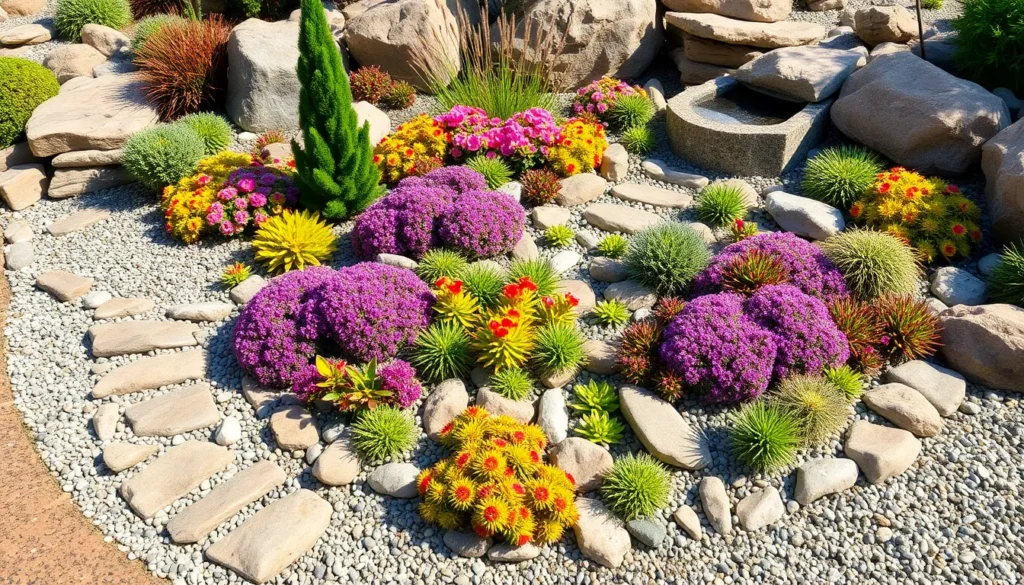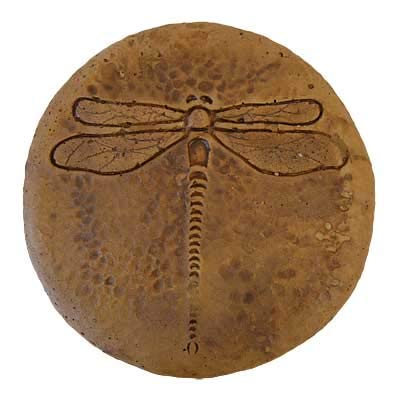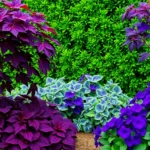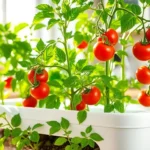Small rock gardens pack incredible visual punch into compact spaces and we’re here to help you create your own stunning miniature industry. These low-maintenance garden features combine the rugged beauty of stones with carefully selected plants to transform even the tiniest outdoor areas into captivating focal points.
Whether you’re dealing with a challenging slope, poor soil conditions, or simply want to add texture and interest to your yard, small rock gardens offer endless creative possibilities. From alpine succulents nestled between weathered boulders to cascading groundcovers spilling over stone edges, these gardens thrive where traditional plantings might struggle.
We’ve gathered the most effective design ideas and plant combinations that’ll help you maximize your space while minimizing maintenance. You’ll discover how to choose the right rocks, select plants that complement your climate, and arrange everything for maximum visual impact. Let’s jump into creating your perfect small rock garden oasis.
Create a Miniature Alpine Landscape
Transform your small rock garden into a stunning mountain retreat by recreating the natural beauty of high-altitude environments. Alpine landscapes offer dramatic textures and resilient plants that thrive in rocky conditions.
Choose Cold-Hardy Mountain Plants
Select dwarf conifers like mugo pine and dwarf Alberta spruce to anchor your alpine design with year-round structure. These compact evergreens withstand harsh weather while maintaining their attractive form in containers or between rocks.
Plant alpine perennials such as creeping phlox, alpine forget-me-nots, and rock cress to create colorful ground-hugging carpets. We recommend spacing these plants 6-8 inches apart to allow natural spreading while preventing overcrowding.
Include succulent varieties like hens and chicks (Sempervivum) and stonecrop (Sedum) that store water in their thick leaves. These drought-tolerant plants require minimal care and produce fascinating rosette patterns that complement rocky surfaces.
Add ornamental grasses such as blue fescue and buffalo grass to introduce movement and texture contrast. Position these grasses in clusters of 3-5 plants to create natural-looking drifts that mirror mountain meadow growth patterns.
Layer Different Stone Sizes for Natural Appeal
Start with large anchor stones weighing 50-150 pounds to establish your industry’s foundation and primary visual points. Place these substantial rocks first, burying one-third of each stone to create the appearance of natural geological formations.
Fill gaps with medium stones ranging from softball to basketball size to bridge the visual transition between large boulders and smaller elements. We position these stones at varying angles to mimic how weathering and erosion naturally arrange mountain rocks.
Scatter small pebbles and gravel in 2-4 inch sizes throughout planting areas to suppress weeds and retain soil moisture. Choose colors that complement your larger stones, typically gray, tan, or reddish hues that reflect local geological characteristics.
Create natural pathways using flat stepping stones 12-18 inches wide that allow easy garden maintenance access. Space these pathway stones 18-24 inches apart for comfortable walking while maintaining the industry’s wild mountain appearance.
Add a Small Water Feature for Ambiance
Install a bubbling rock fountain using a small submersible pump hidden beneath stacked stones to create gentle water sounds. This feature typically requires a 20-30 gallon underground reservoir and consumes minimal electricity while providing continuous mountain stream ambiance.
Build a miniature cascade by arranging flat stones in descending tiers with a recirculating pump system. We recommend a total height difference of 18-24 inches to create visible water movement without overwhelming your compact rock garden space.
Create a shallow reflecting pool using a preformed liner surrounded by natural stone edges to mirror sky and surrounding plants. Keep water depth at 4-6 inches to prevent mosquito breeding while maintaining the reflective surface that enhances your alpine atmosphere.
Position water features strategically near seating areas or main viewing points to maximize their sensory impact. The sound of moving water masks urban noise while attracting beneficial birds and creating a peaceful mountain retreat atmosphere.
Design a Desert-Themed Rock Garden
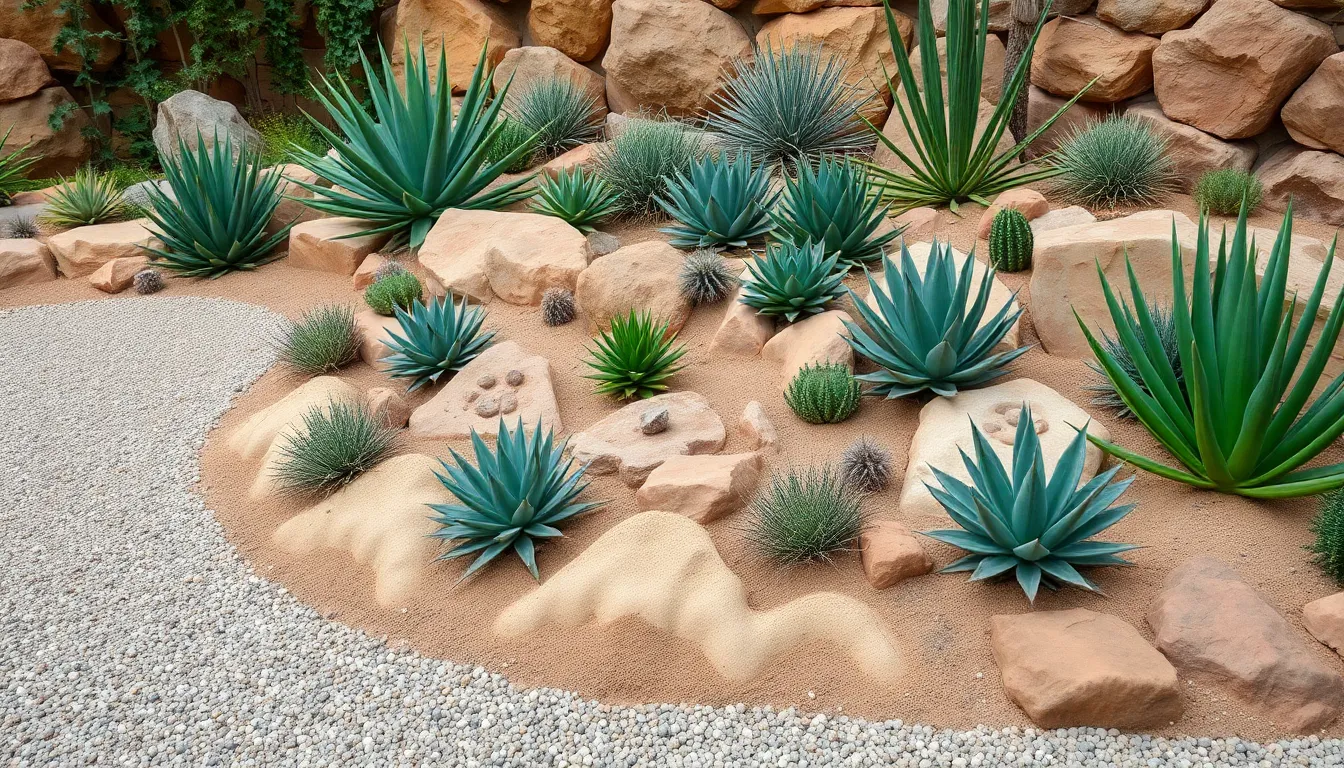
Transform your small rock garden into a stunning desert oasis that requires minimal maintenance while delivering maximum visual impact. Desert themed gardens work perfectly in compact spaces because they use naturally low maintenance plants and materials.
Select Drought-Tolerant Succulents and Cacti
Choose resilient succulents like aloe vera, agave, and echeveria as your foundation plants since they thrive in arid conditions with minimal water requirements. Add cacti species such as prickly pear or cholla to create authentic desert character while ensuring your garden survives dry spells effortlessly.
Arrange plants according to their exact water needs to mimic natural desert groupings and prevent overwatering issues. Group similar species together so you can water efficiently without harming plants that prefer drier conditions. Position taller specimens like agave toward the back and smaller succulents in front to create natural layering that showcases each plant’s unique form.
Use Warm-Toned Stones and Gravel
Select warm toned stones like limestone or sandstone that complement your desert theme and create natural harmony with succulent colors. These materials reflect the authentic palette found in desert landscapes while providing excellent drainage for your plants.
Incorporate rock variations from fine gravel to large boulders to generate visual interest and replicate the diverse textures found in natural desert environments. Place larger stones strategically as focal points while using smaller gravel to fill spaces and create smooth transitions between plant groupings.
Incorporate Decorative Sand Patterns
Create decorative sand patterns that resemble desert dunes or geometric designs to add sophisticated visual appeal to your rock garden space. These patterns serve as artistic elements that tie your entire desert theme together while requiring virtually no maintenance once established.
Install commercial grade industry fabric under rocks and sand to prevent weeds from disrupting your carefully planned design. Ensure your garden maintains a slight slope of 1-2% to prevent water accumulation near structures and create natural drainage that protects both plants and hardscape elements. Design clear pathways using gravel or small stones to direct foot traffic and water flow throughout your desert themed space.
Build a Japanese-Inspired Rock Garden
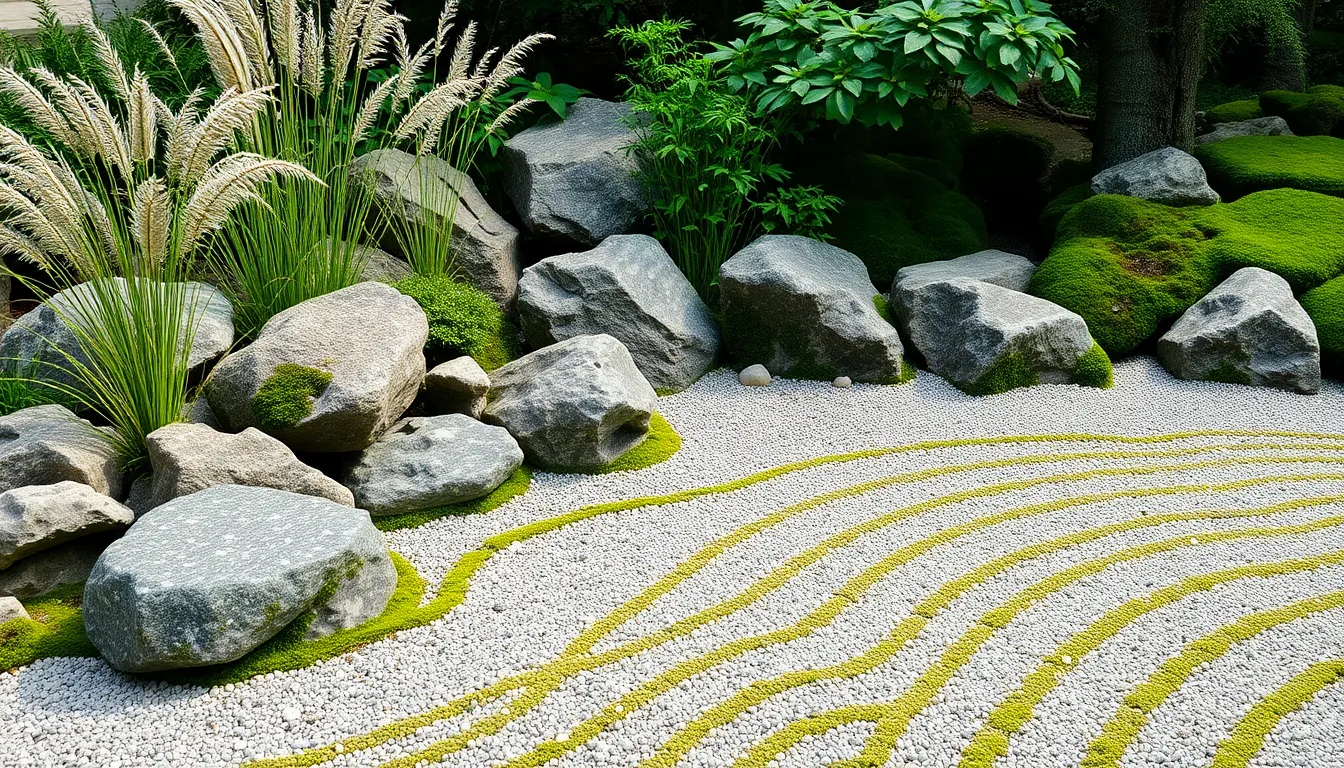
Creating a Japanese-inspired rock garden transforms any small outdoor space into a peaceful sanctuary that embodies simplicity and natural harmony. We’ll guide you through the essential elements that make these gardens so captivating and serene.
Arrange Stones Using Zen Principles
Balancing elements requires placing stones in odd numbers to create visual harmony throughout your garden space. We recommend selecting different sizes and shapes that complement each other while maintaining the minimalist aesthetic central to Japanese design.
Symbolism plays a crucial role when positioning larger stones to represent mountains or islands within your compact industry. Stones should create a natural flow that guides the eye gently across the garden without overwhelming the space.
Visual interest develops naturally when we arrange stones according to traditional principles that emphasize asymmetry and natural placement. Each stone placement should feel intentional yet effortless, mimicking how rocks appear in nature.
Plant Ornamental Grasses and Moss
Ornamental grasses add gentle movement and texture that enhances the garden’s tranquil atmosphere. We suggest choosing compact species that won’t overpower the space while providing seasonal interest through their changing colors and textures.
Moss coverage creates a lush green carpet that softens hard stone surfaces and unifies different garden elements. This natural ground cover thrives in partially shaded areas and requires minimal maintenance once established.
Texture contrast between ornamental grasses and moss provides visual depth without cluttering the minimalist design. Both elements work together to create layers of green that change subtly throughout the seasons.
Create Clean Lines with Raked Gravel
Raked gravel patterns transform simple stone surfaces into artistic expressions that represent water or wind movement. We can create simple straight lines for beginners or more intricate wave patterns for those seeking artistic challenge.
Gravel texture selection focuses on smooth stones that rake easily and maintain their patterns over time. Choose materials that complement your stone colors while providing enough contrast to make the raked patterns visible.
Pattern maintenance becomes a meditative practice that connects us with the garden’s peaceful purpose. Regular raking keeps lines crisp while providing moments of quiet reflection in our outdoor sanctuary.
Construct a Vertical Rock Wall Garden
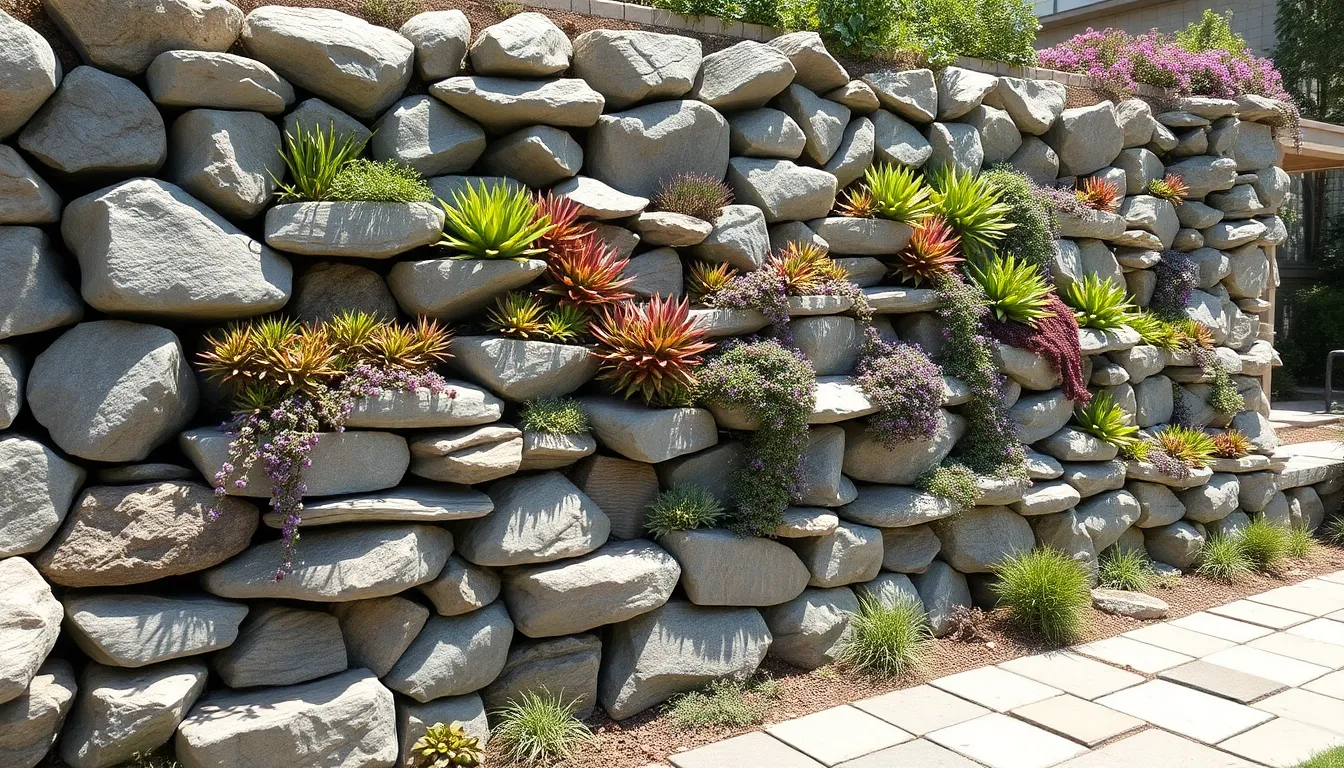
Building a vertical rock wall garden transforms limited space into a stunning three-dimensional display that maximizes growing area while creating dramatic visual impact.
Stack Stones to Create Planting Pockets
Stacking stones strategically creates natural planting pockets that support diverse plant life in compact spaces. We start with a base layer of large stones, carefully positioning them to form stable foundations for subsequent layers. Smaller stones fill gaps between larger ones, creating irregular pockets where soil and plants can thrive.
Layer construction requires attention to both stability and plant access. We ensure each stone sits securely on the one below it, avoiding wobbly arrangements that could collapse over time. Strategic gaps between stones provide essential planting spaces while maintaining structural integrity.
Filling pockets with appropriate growing medium supports healthy plant development. We use a mixture of sand and quality potting soil to create well-draining conditions that prevent root rot. This combination allows water to flow through while retaining enough moisture for plant growth.
Choose Cascading Plants for Visual Interest
Cascading plants transform rigid stone structures into flowing, natural-looking features. We select varieties like sedum and creeping thyme that naturally spill over edges, creating beautiful waterfall effects down the rock face. These trailing plants soften harsh stone lines while adding color and texture.
Plant selection focuses on species that thrive in vertical growing conditions. We choose low-maintenance perennials that adapt well to shallow soil depths and varying light conditions. Succulents prove particularly effective because they store water in their leaves, reducing watering needs in vertical installations.
Strategic plant placement maximizes visual impact throughout the growing season. We position colorful flowering varieties at eye level while using green trailing plants to create connecting elements between different sections. This layered approach creates depth and movement within the vertical garden structure.
Install Proper Drainage Systems
Installing effective drainage prevents water damage and ensures long-term garden health. We create a foundation layer using coarse gravel or sand beneath the stone structure to help water movement. This base layer prevents water from pooling around plant roots and compromises the wall’s stability.
Slope considerations direct water flow away from the structure. We ensure the ground beneath our vertical garden slopes slightly away from any nearby buildings or walkways. Proper grading prevents water accumulation that could undermine the foundation or create muddy conditions.
Incorporating industry fabric beneath rocks controls weed growth while maintaining drainage. We install high-quality industry fabric before placing stones, creating a barrier that blocks unwanted vegetation without impeding water flow. This preventive measure reduces maintenance requirements and keeps the garden looking clean and intentional.
Transform Unused Corner Spaces
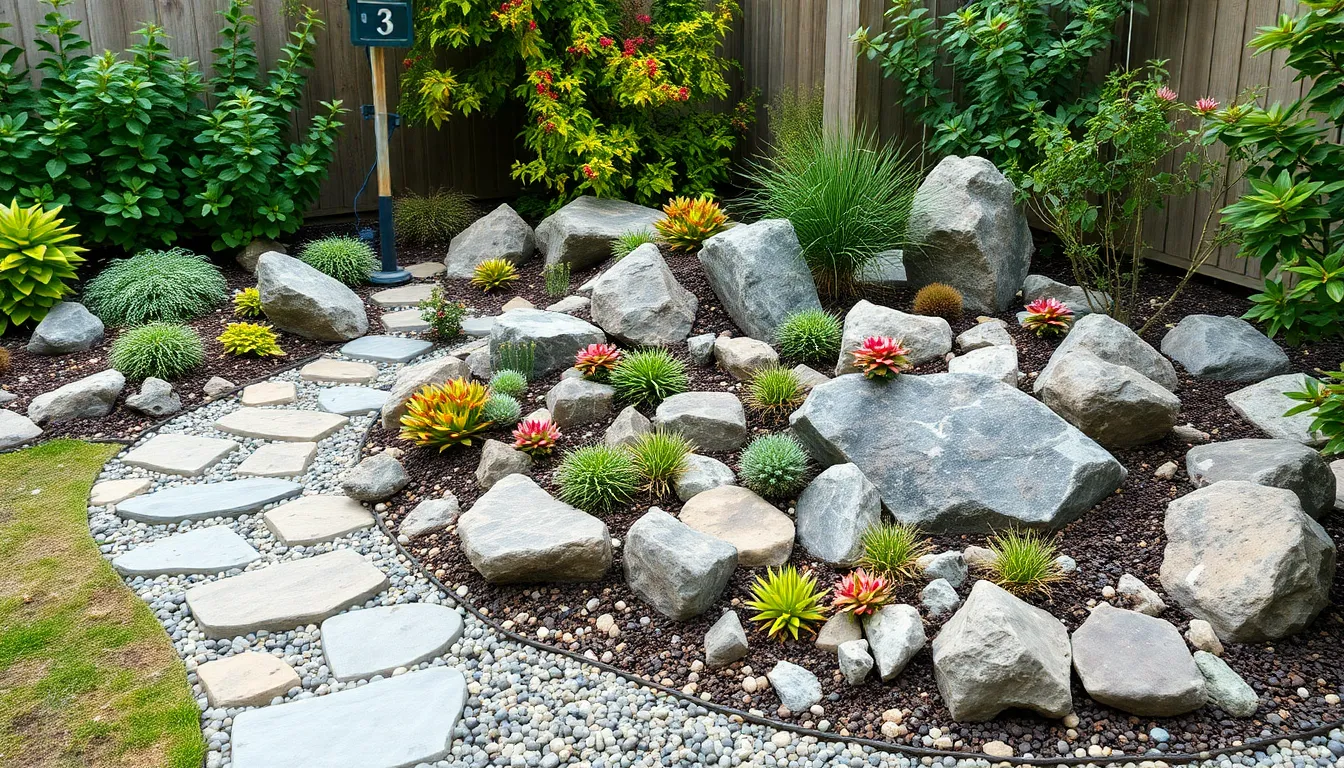
Corner spaces often present unique opportunities for creative rock garden design. We’ll show you how to maximize these challenging areas with strategic planning and thoughtful plant selection.
Use Awkward Yard Areas Effectively
Create pathways through difficult terrain using small rocks to connect different garden sections. These rocky corridors make previously inaccessible areas functional while adding visual appeal to your industry design.
Fill gaps with decorative elements like strategically placed boulders or rock clusters to eliminate dead zones. Position larger stones as natural barriers or sculptural features that transform problematic spaces into garden highlights.
Design vertical rock walls in narrow corner areas to maximize growing space without expanding outward. Stack stones carefully to create planting pockets that support diverse plant communities while maintaining structural integrity.
Install industry fabric underneath your rock arrangements to prevent weed growth and maintain clean lines. Add a sand layer beneath the rocks to improve drainage and stabilize your stone placement for long term success.
Scale Plants to Match Small Dimensions
Choose dwarf varieties like miniature daffodils and compact succulents that won’t overwhelm your limited space. These smaller specimens maintain proportional balance while delivering impressive visual impact throughout growing seasons.
Layer plants strategically using groundcovers like Scotch moss and candytuft to create depth without crowding. Position taller specimens toward the back and shorter plants in front to maximize viewing angles from multiple perspectives.
Select drought tolerant options that thrive in rocky conditions with minimal water requirements. Succulents and alpine perennials adapt well to small rock gardens while reducing maintenance demands over time.
Match plant sizes to container proportions by choosing specimens that complement your available growing space. Avoid aggressive spreaders that might outgrow their allocated areas within a single growing season.
Create Focal Points with Statement Rocks
Position large boulders strategically as centerpiece elements that anchor your entire design composition. These substantial stones draw immediate attention while providing visual weight that balances surrounding plantings and smaller rock features.
Incorporate uniquely shaped stones or create sculptural arrangements that serve as conversation starters. Weathered limestone, colorful sandstone, or granite specimens with interesting textures add personality to corner installations.
Group rocks in odd numbered clusters following natural design principles that create pleasing visual rhythms. Three or five stone arrangements appear more organic than even numbered groupings while maintaining balanced proportions.
Use warm toned materials like limestone and decorative aggregates to enhance your focal point’s visual appeal. Coordinate stone colors with surrounding architecture and existing industry elements for cohesive integration throughout your outdoor space.
Incorporate Colorful Flowering Plants
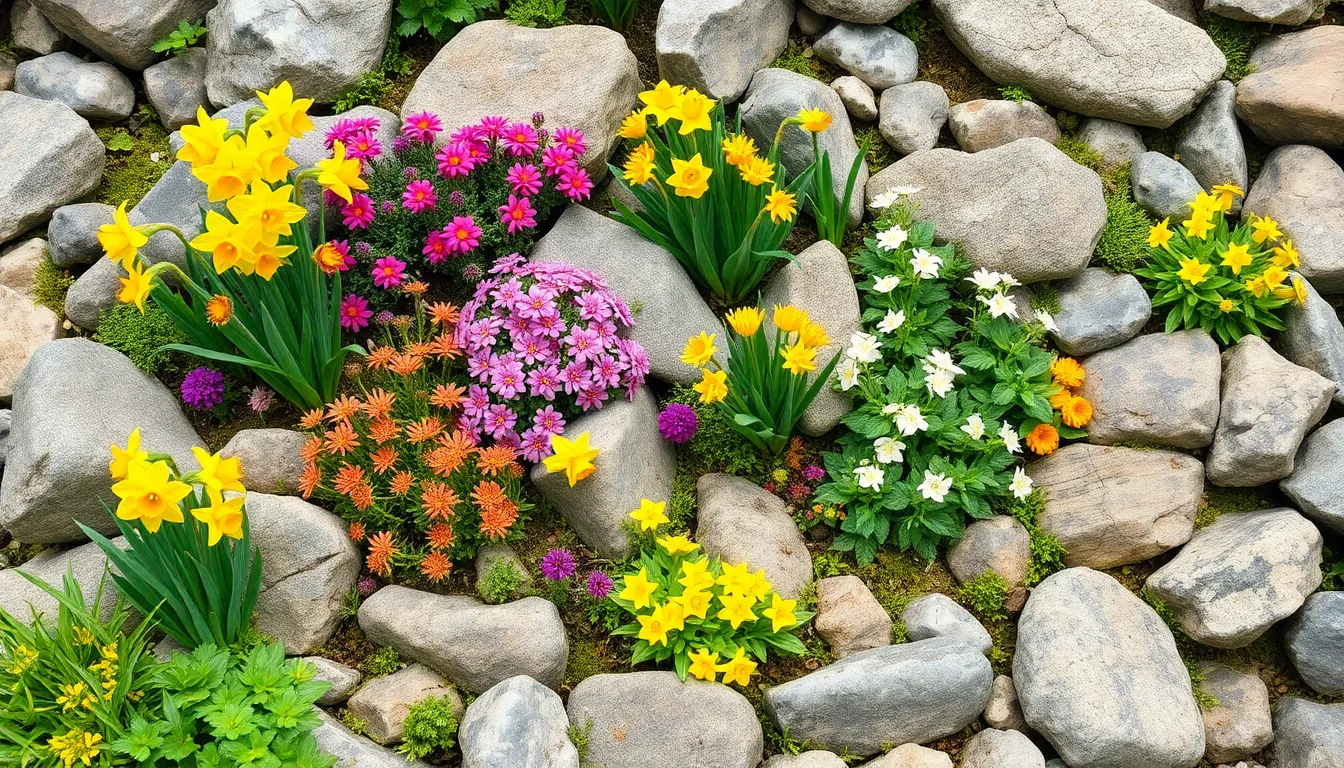
Rock gardens come alive when we add flowering plants that thrive in rocky conditions. These colorful additions transform our stone arrangements into vibrant displays that change throughout the seasons.
Select Perennials That Thrive in Rocky Soil
Daffodils provide bright spring blooms in miniature varieties perfect for small rock gardens. We recommend choosing Narcissus species that stay compact while delivering cheerful yellow and white flowers. Hens and chicks offer year round interest with their distinctive rosette formations and red coloring that intensifies in cooler weather. Sempervivum tectorum creates low growing clusters that spread naturally between rocks.
Lamb’s ear adds silvery texture with its soft, fuzzy foliage that contrasts beautifully against dark stones. Stachys byzantina forms dense mats of silver leaves that brighten shadowy areas. Scotch moss brings golden highlights through its tiny yellow green foliage that creates carpet like coverage. Sagina subulata ‘Aurea’ fills gaps between rocks with its moss like appearance.
Succulents and sedums deliver diverse colors ranging from purple and red to blue green and chartreuse. These drought tolerant plants store water in their thick leaves, making them ideal for rocky conditions. Candytuft creates striking white displays with Iberis sempervirens producing masses of small flowers that cover the plant completely. Wood spurge contributes yellow blooms while Euphorbia amygdaloides adds red stems for extra visual impact.
Plan for Seasonal Color Succession
Spring awakens our rock garden with early blooming daffodils and colorful succulents that emerge from winter dormancy. We suggest planting miniature narcissus varieties that naturalize over time, creating larger displays each year. Summer brings peak flowering from wood spurge and candytuft that provide continuous blooms throughout the warmer months.
Fall transitions showcase sedums and asters that offer rich colors when other plants begin fading. Many sedum varieties develop deeper red and orange tones as temperatures cool. Winter maintains interest through evergreen succulents and snow in summer’s silvery foliage that creates a frosty appearance. Cerastium tomentosum provides white blooms and silver leaves that stand out against winter’s muted palette.
We recommend creating a planting calendar that ensures continuous color by selecting plants with staggered bloom times. This approach maintains visual interest while reducing maintenance requirements throughout the growing season.
Balance Plant Heights and Textures
Short plants form our garden’s foundation with Scotch moss and hens and chicks creating low growing carpets between rocks. These compact varieties won’t overwhelm small spaces while providing consistent coverage. Taller plants add vertical dimension through wood spurge and lamb’s ear that reach 12 to 18 inches in height.
Texture variation creates visual interest by mixing smooth succulent leaves with fuzzy lamb’s ear and spiky sedums. We suggest combining plants with different leaf shapes, sizes, and surface textures to prevent monotony. Strategic placement enhances each plant’s characteristics by positioning shorter varieties in front and taller ones behind for layered viewing.
Color coordination ties everything together through repeating similar hues throughout the garden while varying their intensities. Silver foliage from lamb’s ear and snow in summer creates unity, while colorful blooms provide seasonal accents that change the garden’s personality throughout the year.
Add Practical Pathways and Borders
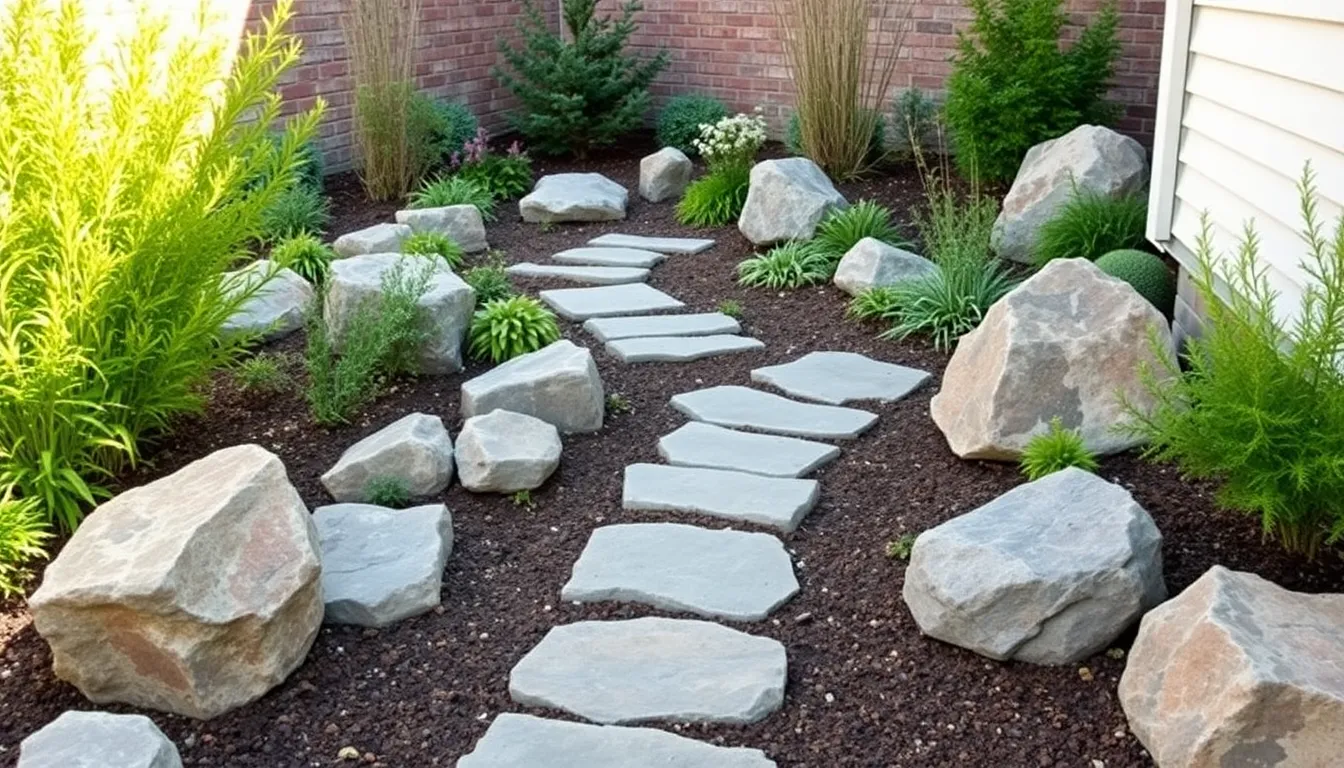
Practical pathways and borders transform your small rock garden from a static display into an accessible, functional industry. These foundational elements create structure while maintaining the natural beauty you’ve worked to establish.
Use Stepping Stones for Garden Access
Stepping stones provide easy access to different areas of your rock garden while protecting soil integrity and preventing erosion. We recommend spacing flat stones 18-24 inches apart to create a comfortable walking rhythm that allows visitors to pause and appreciate plantings along the way.
Position stepping stones strategically to connect key viewing areas like specimen plants or water features. Choose stones that complement your existing rock selection but offer enough contrast to clearly define the walking path. Natural flagstone works exceptionally well because its flat surface provides stable footing while blending seamlessly with surrounding industry elements.
Install stepping stones by excavating slightly deeper than the stone thickness to ensure a level, stable surface. Sand beneath each stone creates proper drainage and prevents shifting over time. Consider the natural flow of foot traffic when placing stones, creating gentle curves that feel organic rather than forced straight lines.
Define Boundaries with Larger Rocks
Larger rocks and boulders create clear boundaries that define different garden areas while adding substantial visual weight to your design. We suggest using stones that are 12-18 inches in diameter to establish prominent borders without overwhelming smaller plantings.
Strategic placement of boundary rocks helps create a sense of enclosure that makes your small space feel more intimate and purposeful. Position larger specimens at key transition points where one garden area meets another, such as where your alpine section transitions to a desert themed zone.
Bury boundary rocks one third of their height to achieve a natural, settled appearance that mimics how stones occur in nature. Group odd numbers of rocks together, such as clusters of three or five, to create more visually pleasing arrangements. Vary the sizes within each grouping to add interest while maintaining the boundary function.
Create Natural Walking Routes
Natural walking routes encourage garden exploration by guiding visitors along predetermined paths that showcase your best plantings and stone arrangements. We design these routes using a combination of small boulders, gravel paths, and strategically placed stepping stones that create an intuitive flow through the space.
Winding paths feel more natural and create opportunities to reveal garden surprises around gentle curves. Place small boulders along path edges to subtly direct foot traffic while providing informal seating spots for garden contemplation. These rocks should be large enough to sit on comfortably, typically 18-24 inches high and wide.
Gravel paths between larger stones create cohesive walking surfaces that require minimal maintenance while preventing weed growth. Choose gravel colors that complement your rock selection, such as decomposed granite for warm toned gardens or crushed limestone for cooler palettes. Maintain path width between 24-30 inches to accommodate comfortable two way traffic in your small space.
Include Decorative Elements and Lighting
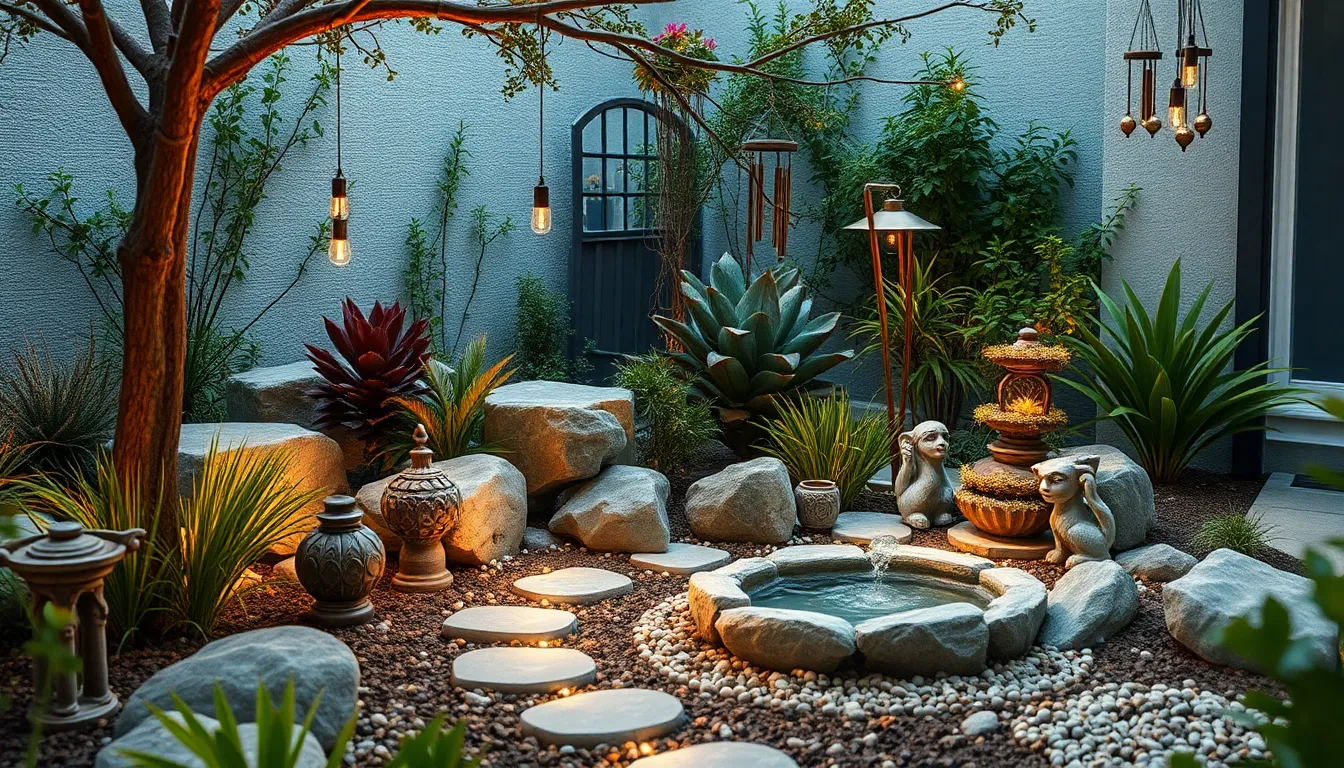
Transform your small rock garden from a simple plant display into an enchanting outdoor sanctuary with carefully chosen decorative accents and strategic lighting. These finishing touches create visual interest during daylight hours while extending your garden’s appeal well into the evening.
Place Garden Sculptures Strategically
Position sculptures near focal points or along pathways to add personality and visual interest to your rock garden design. We recommend selecting pieces that complement your garden’s scale, choosing smaller sculptures for intimate corners and slightly larger ones for main viewing areas. Weather resistant materials like stone, metal, or ceramic work best in outdoor rock garden environments.
Create depth by placing sculptures at varying heights throughout your garden space. Elevated rocks serve as natural pedestals for smaller decorative pieces, while ground level placements work well for broader sculptures that anchor exact garden zones. We suggest avoiding overcrowding by limiting yourself to one or two key pieces that enhance rather than compete with your natural elements.
Choose sculptures that reflect your garden’s overall theme and style preferences. Abstract forms blend seamlessly with modern rock garden designs, while nature inspired pieces like birds or small animals complement traditional alpine settings. We find that neutral toned sculptures in gray, brown, or weathered finishes integrate most successfully with existing rock and plant combinations.
Install Solar Lights for Evening Appeal
Install solar lights among rocks or near pathways to create a warm and inviting glow that highlights your garden’s features in the evening. We recommend placing these energy efficient fixtures at ground level between larger stones, where they’ll charge during daylight hours and automatically illuminate your garden after sunset. This placement strategy creates natural looking accent lighting that doesn’t overwhelm your carefully arranged plant displays.
Select solar lights with warm white LED bulbs rather than cool white options for the most flattering garden illumination. Warm tones enhance the natural colors of rocks and foliage while creating a cozy atmosphere that invites evening relaxation. We suggest choosing lights with long lasting batteries that provide at least 6-8 hours of continuous operation for consistent nighttime appeal.
Create dramatic lighting effects by positioning solar fixtures to cast shadows through ornamental grasses and sculptural plants. Uplighting from below emphasizes interesting rock formations and plant textures, while path level lighting ensures safe navigation through your garden spaces. We recommend starting with 4-6 strategically placed solar lights for most small rock gardens, then adding more fixtures as needed to achieve your desired ambiance.
Add Wind Chimes or Water Sounds
Add wind chimes for soothing sounds that enhance the ambiance of your garden while creating gentle movement and visual interest. We suggest hanging lightweight metal or bamboo chimes from nearby tree branches or installing small posts specifically for this purpose. Position them where prevailing breezes will activate the chimes without overwhelming conversation areas or neighboring properties.
Install a small water feature like a bubbling fountain to create calming effects that mask urban noise and attract beneficial wildlife. Solar powered fountains work exceptionally well in rock garden settings, requiring no electrical connections while providing continuous water circulation. We recommend choosing compact fountain designs that complement your garden’s scale, typically ranging from 12-24 inches in diameter for most small rock garden applications.
Combine both sound elements to create layered auditory experiences that change with weather conditions and seasons. Wind activated chimes provide intermittent melodies during breezy periods, while water features offer consistent background sounds that promote relaxation. We find that positioning these elements at different heights and locations throughout your garden creates the most pleasant and varied soundscape for daily enjoyment.
Conclusion
Creating a stunning small rock garden doesn’t require extensive space or complicated maintenance routines. With the right combination of stones plants and design elements we can transform any compact area into a captivating outdoor sanctuary.
Whether we choose an alpine desert Japanese-inspired or vertical design approach the key lies in thoughtful planning and strategic plant selection. The addition of pathways lighting and decorative elements elevates these gardens from simple rock arrangements to enchanting outdoor retreats.
Most importantly these low-maintenance gardens offer year-round beauty while adapting to challenging growing conditions. By implementing these design strategies we’ll create personalized outdoor spaces that provide both visual appeal and peaceful sanctuary right in our own backyard.
Frequently Asked Questions
What is a small rock garden and why should I consider creating one?
A small rock garden combines stones with carefully selected plants to create a low-maintenance, visually appealing focal point in compact outdoor spaces. These gardens work well in challenging conditions like slopes or poor soil, requiring minimal upkeep while providing year-round interest and beauty.
Which plants work best in rock gardens?
Choose drought-tolerant plants like succulents, alpine perennials, ornamental grasses, sedum, and creeping thyme. For alpine themes, select cold-hardy mountain plants and dwarf conifers. For desert themes, use cacti and aloe vera. Always consider your climate and select plants with similar water needs.
How do I arrange stones for the most natural look?
Layer different stone sizes with larger rocks as focal points representing mountains or islands. Use odd-numbered groupings following Zen principles. Place flat stones as pathways and stack stones to create planting pockets. Choose warm-toned stones like limestone for desert themes.
What are the key design themes for rock gardens?
Popular themes include alpine landscapes with mountain plants and dwarf conifers, desert gardens with succulents and warm-toned stones, and Japanese-inspired gardens featuring raked gravel patterns and moss. Each theme requires specific plant selections and stone arrangements to achieve the desired aesthetic.
How do I create proper drainage in my rock garden?
Install landscape fabric to prevent weeds and ensure water flows away from plant roots. Create planting pockets when stacking stones vertically, and group plants according to their water needs. Use gravel and sand to improve drainage around sensitive plants.
What’s the best way to add color to a rock garden?
Select colorful flowering perennials like miniature daffodils, hens and chicks, and lamb’s ear that thrive in rocky soil. Plan for seasonal color succession with a planting calendar. Balance plant heights and textures while coordinating colors to maintain visual interest year-round.
How can I make my rock garden more functional with pathways?
Use stepping stones spaced 18-24 inches apart for easy access. Create winding gravel paths with small boulders as guides. Design organic routes that reveal garden features and provide informal seating spots while protecting soil integrity and maintaining the natural aesthetic.
What decorative elements enhance a rock garden’s appeal?
Add garden sculptures made from weather-resistant materials, install solar lights with warm white LED bulbs for evening ambiance, and incorporate wind chimes or small water features like bubbling fountains. These elements create sensory interest while maintaining the garden’s natural harmony.
Can I create a rock garden in awkward or corner spaces?
Yes, rock gardens are perfect for unused corners and narrow areas. Use small rocks for pathways, install vertical rock walls to maximize growing space, and select dwarf plant varieties to maintain proportional balance in tight spaces.
How much maintenance do rock gardens require?
Rock gardens are designed for low maintenance. Once established, they need minimal watering due to drought-tolerant plant selections, occasional weeding (reduced by landscape fabric), and seasonal tidying. The raked gravel patterns in Japanese-style gardens provide meditative maintenance opportunities.

